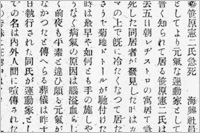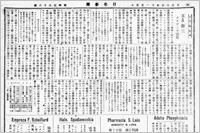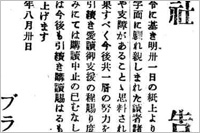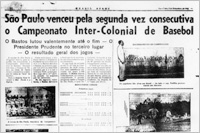Brazilian baseball
In Brazil, a country where football is the national sport, baseball is not as popular a sport as in Japan. In the colonies inhabited by Japanese immigrants, however, they played baseball games on days off with their favorite gloves brought from Japan and handmade bats (Annotation1), in empty lots, sports grounds, soccer fields and other places, as they used to play in Japan. When the number of immigrants increased remarkably in the late 1930s, the "All Brazil Baseball Tournament", an inter-Japanese colonial tournament started to be held. When the baseball team of the Waseda University came to Brazil in 1958, on the occasion of the fiftieth anniversary of Japanese immigration, no local team won a single game out of 16 against the Waseda team, but the steady development of baseball in Brazil have given birth to good players such as Tamaki Henrique Shigeo (pitcher for the Hiroshima Carp and the Tohoku Rakuten Eagles) who played in the Hiroshima Carp from 1995 onwards. Now you will look at two baseball players in the early stage of baseball in Brazil.
Kenji Sasahara and the Mikado Club
Japanese immigrants were not actually the first to play baseball in Brazil. Between the late 19th and early 20th century, engineers of U.S. power and telephone companies had already played baseball in Brazil before Japanese immigrants arrived. In São Paulo State with large Japanse populations, these engineers played baseball with amateur baseball players in the U.S. Consulates and others at the Palestra Italia Stadium (the forerunner of the current Palmeiras Soccer Stadium). Around 1917, a Japanese youth joined an American baseball team in São Paulo State and played with Americans. His name was Kenji Sasahara. He was larger and stronger than an ordinary Japanese, and he soon became a leading figure after he joined the team. He had so good results, that even after he left the team, he was always asked to pitch in games between representative American teams in São Paulo and Rio de Janeiro States.
Born in 1889 in Shizuoka Prefecture, Sasahara emigrated to Brazil in 1915. After leaving Keio University Preparatory School due to his family's financial problem in 1912, Sasahara went to Europe and then to Brazil with a hometown friend. They were a so-called "independent emigrant". When he arrived in Brazil, Sasahara sought to make a carrer in farming such as cultivating tobacco or other crops, but in vain. He moved to São Paulo City and began to trade in vegetables with Americans, who suggested him to join an American baseball team.
Many Japanese immigrants living in São Paulo City played baseball. After the establishment ceremony of the São Paulo Young Men's Association in 1916, the opening ceremony of a game cerebrating the formation of the association’s baseball club was held and the members of the club played "a game played like baseball" in an empty lot in the site of a tobacco factory, later dubbed the "Akatsuchi-ga-hara field", the "Sudan Field " or other nicknames, situated just down the slope in the Conde de Sarzedas Streets, which was a Japanese densely populated area at the time. Sasahara arrived in São Paulo the following year, who played with American teams for some time, but soon became acquainted with Japanese amatuer baseball players living in São Paulo. Before then the association's baseball club could not had carried the minimum number of players necessary to have regularly scheduled games, which led Sasahara to think of forming a full-size baseball team comprised of Japanese players alone.
In May of 1920, the Mikado Sports Club (Annotation2) was created and Sasahara was appointed manager. In the team's first game next month in which Sahara pitched, they lost against an American team. Mikado Club were mainly engaged in playing games against teams of Americans living in São Paulo and crews teams of Japanese and American ships that were at anchor in the port of Santos, and intrasquad games. It was said that Amrican teams sometimes provided the club with a pick-up and drop-off and and meals, when playing games against them, perhaps because of friendship between baseball teams or thirst for an opponent. In November 1921, a rival team, the "Rappa Baseball Team" was formed, and regularly scheduled matches were held between the Mikado and the Rappa. In games against American teams Sasahara played as a pitcher, but between Japanese teams he always played as a catcher, perhaps to balance the teams.
Sasahara was employed by a company established for carrying out a government policy, the Kaigai Kogyo Kabushiki Kaisha (Overseas Enterprise Company) perhaps owing to his great athletic achievments, and was transferred to the Registro branch in 1923 where he continued to devote himself to popularize baseball. The Registro team led by Sasahara went to São Paulo City and participated in the First Samejima Flag Tournament held at Aclimacao Park in 1924 vying for the champion flag offered by a building contractor, Naoya Samejima and became the first champion. Baseball became so popular thanks to Sasahara who was good-natured and coached enthusiastically, that at one time 7 or 8 teams were formed in Registro alone. Sasahara, however, died young suddenly of a brain hemorrhage in June of 1926. He died still single at 39 and it is not too much to say that he devoted his short life exclusively to the diffusion of baseball into Brazil. He was respectfully introduced in a report of his death in a newspaper, which said "Mr. Kenji Sasahara who was better known as a vigorous athlete than as an employee of Kaiko (Kaigai Kogyo)".
Isamu Yuba and the Alianca Team
While a memorial game was held in honor of Sasahara on the "Akatsuchi-ga-hara" field in São Paulo City, a newspaper reported, "a few dozen vigorous men in Alianca have formed a baseball team with a full set of equipment ordered from Japan". The leading figure among these "vigorous men" was Isamu Yuba who later came to be known as the founder of the "Yuba Farm" (Annotation3). Yuba was famous as a strong shoulder pitcher in his high school days although he had never participated in the Koshien Tournament and he had strong motivation to play baseball. While baseball teams of other Japanese settlenments refused an invitation of the Samejima Flag Tournament owing to lack of players and money for traveling to São Paulo City, Alianca Colony team, to which Yuba belonged, undertook the cutting down of trees in mountains to raise money for traveling and thus consecutively participated in the tournament. Although the name called the "Samejima Flag Tournament" is magnificent, in fact it had consisted of 2 teams alone, the Alianca and São Paulo teams, for 3 years since Alianca participated in it for the first time. When the team participated in 1926 for the first time with great enthusiasm, they lost Mikado due to insufficient practice, and it was said that Yuba shed tears of regret in the presence of others. "Nippaku Shimbun" (The Nippaku(Japan-Brazil) Newspaper) commented humorously on the game:
"At 5 o'clock the Mikado laughs while Alianca cries. Is this the judgement of the god of destiny? The combined team which had no team unity won without any practice. The causes of the winning was the difference in the skill, or between wearing cleats and not wearing ones?"
While the urban Mikado team had a full set of equipment including cleats, the Alianca team coming from a rural village did not have sufficient equipment, playing the game in canvas shoes. In addition, the superior defensive team was the stronger on an ill-prepared uneven field. Turning the regret into motivation, the Alianca team dedicated themselves to strenuous practice, and afterwards, became unrivaled and won three consecutive championships. It was said before the tournament in 1928 for the team’s 3rd consecutive victory, the team went all the way to the city of Lins and conducted a one month training camp there with enthusiasm. This shows that Yuba already had leadership and single-mindeness in his early 20s, based on which he later idealistically built the agricultural community (Comunidade Yuba) that bore his name.
Yuba was always bragging that during his high school days in Japan, he had struck out a slugger Minoru Yamashita who later entered Keio University and became famous together with Shigeru Mizuhara. This story could not just for appearance sake! He overhand threw strong fastballs, mixing in curvballs breaking downwards, without considering levels of batters in Brazil and piled up the sheer number of strikeouts there as well. Opponent teams consisting of beginner baseball players devised bunting tactics for knocking out Yuba that even those players could execute. Yuba was confident in his fastball, but it was reported, with a bit of exaggeration, that he was in a poor fielding position after making a pitch, perhaps owing to making a pitch with all his strength, and fielding a bunted ball, he always threw it wildly to first base.
All-Brazil Baseball Tournament
From the 1930's onwards, a regional baseball competition began to be held in each region, including the São Paulo City Baseball Championship in São Paulo City and its suburbs, the Noroeste Baseball Tournament in Noroeste (northwest) region, São Paulo State, where Alianca and other Japanese settlements were located, owing to traveling costs and the increase in the number of teams and players in Japanese settlements according to the increase in the population of Japanese immigrants. After the period of the regional expansion, the first "All-Brazil Baseball Tournament" was held in 1936 in São Paulo City with participants from Bastos, Tiete, Paraguacu and São Paulo. Although the Alianca team insisted that a regional qualifier system should be used in the tournament and did not participated the first tournament in which it was not used, they participated in the 2nd tournament in which it was adopted. From the 3rd tournament onwards the "Nippaku Shimbun Sha" (Nippaku (Japan-Brazil) Newspaper Company)" sponsored the tournaments and spectors were charged for admission to the games and the tournaments were grandly held. The 6th tournament (Annotation4) was held in 1941, but afterwards, with the outbreak of the Pacific War, Japanese immigrants were prohibited to assemble and after the 6th tournament any official game could not be held before the end of the war.
| Annotation1 | Trying to use many tree species growing naturally in Brazill one after another for bat-making, they found some too heavy, some to break too easily and the guava tree unexpectedly suitable for it. |
|---|---|
| Annotation2 | Mikado Sports Club was intended for not only baseball but other various sports including tennis and table tennis. |
| Annotation3 | Yuba Agricultural Community is a coorporative farm built under the leadership of Isamu Yuba based on an ideal of "Esthnic Japanese creating new culture". The farm became well known in Brazil for the Yuba Ballet Company in which people who worked on the farm perfomed as dancers. Members of the community use Japanese to live their lives among it. |
| Annotation4 | The tournaments were held at the said Palestra Italia Stadium, the Sudan Field, and empty lots in factories and pastures. In some soccer fields the distance to the left field fence alone was extremenly short and empty lots in pastures were uneven owing to ill-preparedness, so there often occurred bad bounces and uneven rolls. In contrast to fields in São Paulo City, Japanese settlements in outlying regions, where it was easy to secure land, first of all built fields exclusively for baseball as an entertainment facilitiy. |
-
 The sudden death of Sasahara Kenji
The sudden death of Sasahara Kenji -
 "There are a few dozen strenuous men in Alianca"
"There are a few dozen strenuous men in Alianca" -
 The Third Naoya Samejima Tournament – the first-time participation of the Alianca team
The Third Naoya Samejima Tournament – the first-time participation of the Alianca team -
 The First All-Brazil Baseball Tournament
The First All-Brazil Baseball Tournament -
 The Third All-Brazil Baseball Tournament
The Third All-Brazil Baseball Tournament -
 Company notice of the discontinuation of Japanese language pages alone in a newspaper on August 30, 1941
Company notice of the discontinuation of Japanese language pages alone in a newspaper on August 30, 1941 -
 The Sixth All-Brazil Baseball Tournament (Newspaper cover in Portuguese)
The Sixth All-Brazil Baseball Tournament (Newspaper cover in Portuguese)














